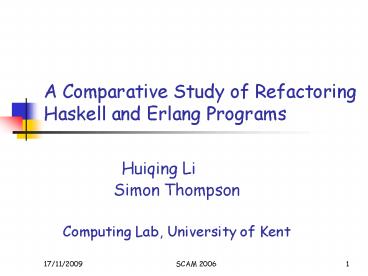A Comparative Study of Refactoring Haskell and Erlang Programs - PowerPoint PPT Presentation
1 / 14
Title:
A Comparative Study of Refactoring Haskell and Erlang Programs
Description:
Wrangler: the Erlang refactorer. Model checking of Erlang programs. Testing of Erlang programs. ... The Erlang Refactorer, Wrangler, is implemented in Erlang. ... – PowerPoint PPT presentation
Number of Views:60
Avg rating:3.0/5.0
Title: A Comparative Study of Refactoring Haskell and Erlang Programs
1
A Comparative Study of Refactoring Haskell and
Erlang Programs
- Huiqing Li
- Simon Thompson
- Computing Lab, University of Kent
2
Background
- Haskell a lazy, statically typed, purely
functional programming language featuring - higher-order functions, polymorphism, type
classes and monadic effects. - Erlang a strict, dynamically typed functional
programming language with support for
concurrency, communication, distribution and
fault-tolerance.
3
Background
- The Refactoring Functional Programs project
(2002-2005). - HaRe the Haskell Refactorer.
- The Formally-Based Tool Support for Erlang
Development project (2005- 2008). - Wrangler the Erlang refactorer.
- Model checking of Erlang programs.
- Testing of Erlang programs.
4
A Refactoring Example
- Generalise a function definition.
-module (test). -export(f/1). add_one
(N, HT) -gt HN add_one(N,T) add_one
(N,) -gt . f(X) -gt add_one(1, X).
-module (test). -export(f/1). add_one
(HT) -gt H1 add_one(T) add_one () -gt
. f(X) -gt add_one(X).
5
Haskell Vs. Erlang -- refactoring
opportunities
Haskell Refactorings
Erlang Refactorings
Introducing/removing concurrency, Asynchronous/syn
chronous communication, Refactoring to design
patterns, . . . . . .
Type/type class-related refactorings. Monad-re
lated refactorings . . . . . .
Renaming, Removing unused definitions/parameters,
Swapping arguments, Introducing a new
definition, . . . . . .
6
Tool Support for Refactorings
- Behaviour-preservation. Given the same input
value(s), the program should produce the same
output value(s) before and after the refactoring. - Program appearance preservation. A real-world
refactoring tool should preserve the original
program layout and comments as much as possible.
7
Refactoring Condition Transformation
- Our experience for most refactorings, the
side-condition analysis is more complex than the
program transformation part. - Some typical static semantic analysis used during
side-condition analysis and program
transformation - Binding structure of variables,
- Function call graph,
- Module graph,
- Type information,
- Side Effect (only for Erlang programs).
8
Refactoring Condition Transformation
- Our observation analysing Erlang programs is in
general more complex than analysing Haskell
programs because of Erlangs flexibility and some
dynamic aspects. e.g. weak type information,
dynamic function calls, etc. - Example 1
- start( ) -gt spawn (ch1, ch1, ).
- Example 2
- foo ( ) -gt M blah, F
list_to_atom(fun1), - MF().
9
Program Layout Preservation
- Haskell people tend to stick to their own layout,
therefore standard pretty-printer does not help
too much. - Erlang people tend to accept the standard layout,
partially because most Erlang people use Emacs as
the editor, therefore standard pretty-printer is
acceptable.
10
Implementation
- The Haskell Refactorer, HaRe, is implemented in
Haskell, - The Erlang Refactorer, Wrangler, is implemented
in Erlang. - In the implementation of HaRe, lots of effort
has been put to comment and layout preservation,
whereas much more effort has been put to the
program analysis part for the implementation of
Wrangler.
11
Snapshot of HaRe
12
Snapshot of Wrangler
13
Conclusion and Future Work
- Both Haskell and Erlang benefit from the
referential transparency property of functional
programming languages. - Different language characteristics and
programming idioms affect the catalogue of useful
refactorings. - Refactoring Erlang programs involves more
complex static semantics analysis. - Building a language-generic refactorer can be
very challenging in practice. - Future work examine more Erlang refactorings in
novel areas (e.g. concurrency).
14
Questions?































